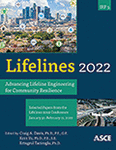Planning for Post-Earthquake Fires Considering Performance of Transportation and Water Networks
Publication: Lifelines 2022
ABSTRACT
Fire following earthquake as a cascading event can cause major losses in a community. This study quantifies induced earthquake damages to water and transportation networks and the building inventory to model fire following earthquake losses considering the response time of fire department, suppression actions, and fire spread inside and between the buildings. The fire engine assignments are completed by incorporating a decision-making algorithm to minimize losses. The model assigns fire engines dynamically over time, and incorporates the post-disaster changes in response time and water network serviceability level as a result of the earthquake. The framework is applied to a case study to investigate potential regions with vulnerability, which in-turn can be used for preparedness and mitigation as part of resilience planning. The efficiency and adequacy of fire department emergency response are shown to be dependent on the locations of ignition and building layout in the community.
Get full access to this article
View all available purchase options and get full access to this chapter.
REFERENCES
Abrash, M. (1997). Michael Abrash's Graphics Programming Black Book, Coriolis Group Books, AZ.
Behnam, B. (2017). Post-Earthquake Fire Analysis in Urban Structures: Risk Management Strategies, CRC Press, 1st edition, Boca Raton, FL.
Boulos, P., Lansey, K., and Karney, B. (2004). Comprehensive water distribution systems analysis. Handbook for Engineers and Planners. 2nd edition, Pasadena, CA.
Boykov, Y., and Kolmogorov, V. (2004). “An experimental comparison of min-cut/max-flow algorithms for energy minimization in vision.” IEEE Transactions on Pattern Analysis and Machine Intelligence 26 (9), 1124–37.
Cadorin, J. F., and Franssen, J. M. (2003). “A tool to design steel elements submitted to compartment fires—OZone V2. Part 1: pre-and post-flashover compartment fire model” Fire Safety Journal, 38 (5), 395–427.
Coar, M., Garlock, M., and Elhami Khorasani, N. (2020). “Effects of water network dependency on the electric network for post-earthquake fire suppression.” Sustainable and Resilient Infrastructure, 5(5), 269–288, https://doi.org/10.1080/23789689.2018.1563408.
Dijkstra, E. W. (1959). “A Note on Two Problems in Connexion with Graphs” Numerische Mathematik, 1(1).
Elhami Khorasani, N., Gernay, T., and Garlock, M. E. M. (2017). “Data-driven probabilistic post-earthquake fire ignition model for a community.” Fire Safety Journal, 94, 33–44.
Elhami-khorasani, N., and Sarreshtehdari, A. (2020). A Loss Estimation and Decision-Making Tool for Managing Fire Following Earthquake, US Geological Survey, G19AP00055.
Eurocode EN-1991. (2002). Eurocode 1: Actions on structures – Part 1-2: General actions – Actions on structures exposed to fire.
FEMA. (2014). Hazus: MH 2.1 technical manual - earthquake model,. Federal emergency management agency. Mitigation Division, Washington, DC.
Fendell, F. E. (1965). “Ignition and extinction in combustion of initially unmixed reactants.” Journal of Fluid Mechanics, 21(2), 281–304.
Himoto, K., and Tanaka, T. (2002). “A physically-based model for urban fire spread.” International Association for Fire Safety Science, 129–140.
Himoto, K., and Tanaka, T. (2005). “Transport of disk-shaped firebrands in a turbulent boundary layer.” Fire Safety Science, 8: 433–444.
Himoto, K., and Tanaka, T. (2012). “A model for the fire-fighting activity of local residents in urban fires.” Fire Safety Journal, 54, 154–166.
Hudnut, K. W., Wein, A. M., Cox, D. A., Porter, K. A., Johnson, L. A., Perry, S. C., Bruce, J. L., and LaPointe, D. (2018). The HayWired earthquake scenario—We can outsmart disaster., Reston, VA.
Lee, S., and Davidson, R. (2010). “Physics-based simulation model of post-earthquake fire spread.” Journal of Earthquake Engineering, 14(5), 670–687.
Quintiere, J. G., and Rangwala, A. S. (2004). “A theory for flame extinction based on flame temperature” Fire and Materials, 28, 387–402.
Sarreshtehdari, A., and Elhami-Khorasani, N. (2020). “Post-earthquake emergency response time to locations of fire ignition”, Journal of Earthquake Engineering, 1–28, https://doi.org/10.1080/13632469.2020.1802369.
Sarreshtehdari, A., Elhami Khorasani, N., and Coar, M. (2020). “A streamlined approach for evaluating post-earthquake performance of an electric network.” Sustainable and Resilient Infrastructure, 5(4), 232–251.
Scawthorn, C. R., Eidinger, J. M., and Schiff, A. J. (2005). Fire Following Earthquake. American Society of Civil Engineers.
Sekizawa, A., Ebihara, M., and Notake, H. (2003). “Development of seismic-induced fire risk assessment method for a building.” Fire Safety Science, 7, 309–320.
Waterman, T. (1969). Experimental study of firebrand generation, Chicago, IL.
Zhao, S. (2010). “GisFFE—an integrated software system for the dynamic simulation of fires following an earthquake based on GIS.” Fire Safety Journal, 45(2), 83–97.
Information & Authors
Information
Published In
History
Published online: Nov 16, 2022
Authors
Metrics & Citations
Metrics
Citations
Download citation
If you have the appropriate software installed, you can download article citation data to the citation manager of your choice. Simply select your manager software from the list below and click Download.
